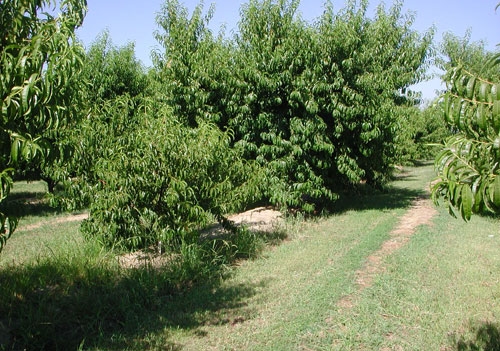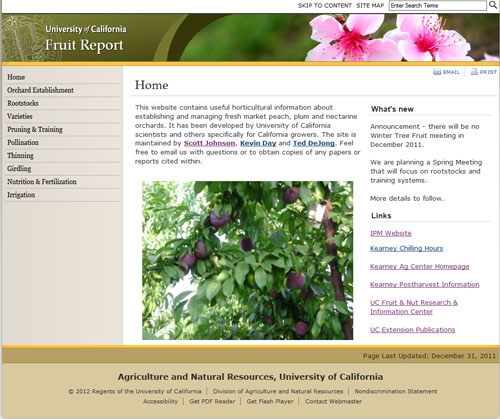Posts Tagged: Kevin Day
Dwarfing rootstocks developed at Kearney cut peach farming expenses

UC Kearney Agricultural Research and Extension Center scientists have found that production costs can be cut dramatically by growing “dwarf” trees that minimize the need for ladder access. However, the limiting factor for peaches has been the lack of acceptable dwarfing rootstocks for the best peach varieties.
In 1987, UC and USDA scientists began a landmark rootstock evaluation project. More than 100 varieties that were either collected or bred by USDA plant breeder David Ramming were planted at Kearney. Five trees each of O'Henry peach and Santa Rosa plum were grafted on the rootstocks and extensively evaluated over the next seven years.
For peach, eight selections showed good potential as dwarfing or semi-dwarfing rootstocks and were propagated for further evaluation. In 2004, two of these were patented as the slightly dwarfing rootstock, “Controller 9,” and the very dwarfing rootstock, “Controller 5.”
At UC Davis, now retired researcher Fred Bliss bred rootstocks using Harrow Blood and Okinawa as parents. UC Davis pomologist Ted De Jong has taken over the program, which patented and released three new rootstocks: Controller 7, Controller 8 and Controller 9.5. A fourth, Controller 6, will be released soon.
The research blocks with Controller 6, 7, 8, and 9.5 at Kearney are continuing to be monitored for production performance and sustained productivity. So far, their performance looks positive but, because of funding cuts, the long-term outlook for maintaining the plots is questionable, De Jong said. UC Cooperative Extension farm advisor Kevin Day is conducting trials of “controller” rootstocks in conjunction with growers to help them determine which ones best fit their farming operations.
De Jong said there is significant interest in Controller 9 because it has been available the longest. Trees on Controller 9 are only slightly reduced in size but require significantly less pruning than trees on the standard rootstock, Nemaguard. There is also substantial interest in Controller 6 by growers who are more aggressive in their interest in smaller trees. Controller 6 causes a substantial reduction in tree size without reducing fruit size.
“I think that Controller 7 may be an optimal choice for many growers because it offers modest size-control and trees on it have had excellent production characteristics and is not such a large leap to a smaller tree,” De Jong said. “However there has been limited interest in it thus far.”
Controller 5 likely makes trees too small for commercial California peach production and trees on it tend to produce smaller fruit. However, it has good potential for home gardeners who have limited space, prefer not to prune much and aren’t very concerned about fruit size.
De Jong, Day, UC Davis pomology specialist Scott Johnson and numerous students have conducted extensive research concerning the dwarfing mechanism involved in these rootstocks and published more than 10 scientific articles on different aspects of the research. These articles and more information about the California Rootstock Breeding Program are available on the UC Fruit Report website.
New “UC Fruit Report” launched
A newly redesigned website, the UC Fruit Report, was launched at the beginning of 2012 with comprehensive information for Central Valley tree fruit producers. The website contains research and photos that three UC Cooperative Extension advisors and specialists developed and collected over the past 30 years.
Website visitors will find useful horticultural information about establishing and managing fresh market peach, plum and nectarine orchards. UC pomology specialist Scott Johnson, who is based at the Kearney Agricultural Research and Extension Center, devoted half of his year-long sabbatical in 2011 to aggregating the information online.
“The website has a lot of information that will help farmers,” Johnson said. “If they’re seeing symptoms on their leaves that they think is a nutrient deficiency, they can go into the site and look at pictures and compare. If they’re planning future orchards, they can go through 35 different rootstocks, from dwarfing rootstocks to those that are resistant to certain diseases.”
The basic information on the website is concise and easy to read. The entries include links to detailed research reports for those who wish to explore the topics further.
The site is maintained by Johnson, Tulare County UCCE farm advisor Kevin Day and UC Davis-based pomology specialist Ted De Jong. They will periodically update the website to reflect the newest research findings and post timely news.
“For example, if we’re seeing a problem with mites,” Johnson said. “We can put that up on the web, where farmers can find solutions to the problem.”
Separate sections in the website are devoted to:
- Orchard establishment
- Rootstocks
- Varieties
- Pruning and training
- Pollination
- Thinning
- Girdling
- Nutrition and fertilization
- Irrigation

The new UC Fruit Report website contains information collected over 30 years.